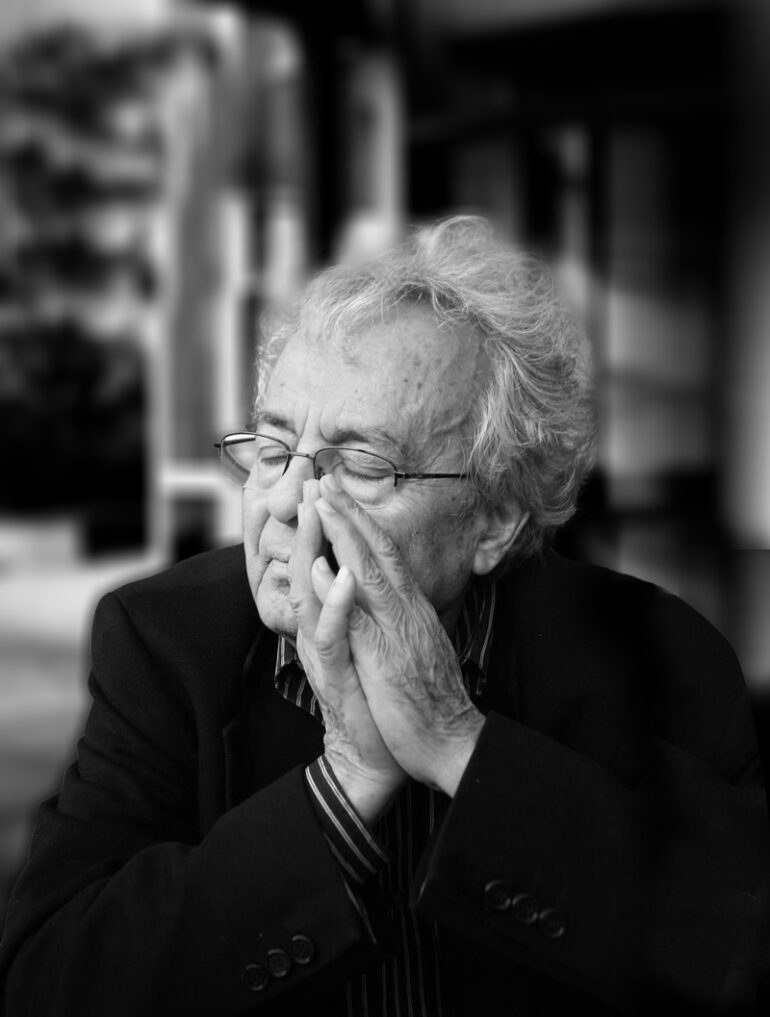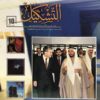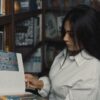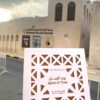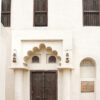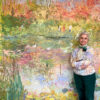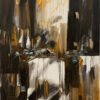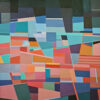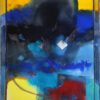Amidst the realms of artistic expression
poised delicately between poetry and art
Ali Ahmed Sa’eed Esber, known as ‘Adonis’ after the Phoenician legend, is a thinker, poet, and artist of Syrian origin who holds the Lebanese nationality that he and his family obtained in 1963. In an interview with a Lebanese newspaper, the late poet Nizar Qabbani described Adonis as “The most beautiful gift presented by the mountains of Syria to the mountains of Lebanon.”
He was born in al-Qassabin village in the city of Jableh in Syria and was not enrolled in formal education until thirteen years old. He memorized the Qur’an with the help of his father who was a poet. Adonis also memorized a large number of poems by ancient poets. He graduated from the University of Damascus in 1954, majoring in philosophy. His thesis pertained to al-Makzoon al-Sinjari (1187-1240), an Alawite prince, poet, jurist, and Sufi. In 1954, he joined the military service and spent a year in prison without trial because of his affiliation at that time with the Syrian Social Nationalist Party which he organizationally left in 1960. He moved to Lebanon in 1956 in which he met the poet Youssef Al-Khal after many correspondences between them, and then they jointly published a poetry magazine in early 1957. Adonis also published ‘Mawaqif’ journal between 1969 and 1994. In 1971, he started teaching at the Lebanese University, Faculty of Education, and kept up until 1985. In 1973, he obtained a doctorate in literature from Saint Joseph University in which his thesis ‘The Constant and the Transforming’ was considered one of his most prominent writings. As of 1955, he was repeatedly invited as a visiting professor to universities and research centers in France, Switzerland, the United States, and Germany. He received a number of international awards and titles of honor, and his works have been translated into thirteen languages, not to mention some oriental languages, such as Turkish, Kurdish, Persian, Indonesian, and Chinese. In 1986, Adonis was invited to be represent the Arab League delegation to UNESCO, so he moved with his family to Paris, and he remained in this position until 1991. He taught Arabic literature at the University of Geneva between 1989 and 1995, and in 1986 he won the Grand Prix in Brussels and then the Golden Crown Award for Poetry in the Republic of Macedonia, October 1997.
Adonis’ journey in Lebanon was marked by his involvement in the Lebanese cultural field via establishing cultural institutions. In 1960, he established ‘Afaq’ magazine which mainly pertains to philosophical and political thought and to literature in general. He participated in the activities of the Lebanese Symposium founded by Michel Asmar in 1946, especially the Islamic-Christian dialogue seminars in 1967 and the ‘After June 6, 1967, Where is Lebanon?’ lectures. In 1967, Adonis was among the founding members of the Lebanese Writers Union. In 1968, he was among the founders of the Afro-Asian Writers’ Association. Later, he participated in the activities of the House of Art and Literature, which was founded by Janine Rubeiz.

Adonis: “Untitled,” several materials on paper, 2011. In this work, Adonis uses scraps of newspaper and small electronic pieces for the first time. The work is about peace and hope alongside the cruelty of injustice, persecution, and war. It expresses the relationship between heritage on the one side and modernism and technology on another side. While Arabic calligraphy art represents heritage, modernism and technology are represented in a form that suggests a person made of iron and expendable electronic tools, extending his hands in both directions, making his body the center of the painting, passing through it to the shape of the geographical dimension of Palestine, and renewing the type of conflict to confirm that the body is one despite some damage.

Adonis: “Untitled,” various materials on paper, 1993. In this work, Adonis uses Arabic calligraphy as a visual language without addition of meaning. He rather uses the shape of letters with their bends and inflections, which creates an archaeological form that indicates the strength of metal and stone’s survival with the calligraphy’s splendor and flexibility. The result is a painting that ranges between strength, gentleness, and softness. This fusion is reinforced through a piece of woven red cloth, so the relationship between the stages of human development and what is ancient and archaeological appears in a structure that targets the dimensions of the development of the letter’s shape despite the difference in civilizations.
– 1 –
قــــــالـــــت الأرض فـــــــي جــــــــــذوري أبـــــــادُ
حـــــــــــنيــــــن ، وكـــــــــــــلُّ نبــــضــــي ســــــــــؤالُ
بــــــيَ جــــــــوعٌ إلـــى الجمــــال ، ومن صــــدريَ
كــــــــان الهـــــــــــــوى ، وكـــــــــان الجــمـــــــــــالُ
– 2 –
مالـــــيَ اليــــــوم أستفـــــيقُ ، فــــلا حقــــــلي
نــــضــــــــــــــــــــــيرٌ ، ولا تــــــــــلالي زواهِـــــــــــــــــرْ
لا النـــــــواطير يسمــــــــرون مـــــــع النّجـــــــــم
ولا الضــــــــــــوء راتـــــــــعٌ فـــــــي المحـــــــــاجــرْ
أنـــــا كـــــــــــنزٌ مخـــــــــبّأٌ ، أيـــــــــن أبنــــــــائــــــــي
فكـــــــــلّــــــي صــــــــــوتٌ ، وكــــــــلّـــــي حناجـــــــرْ
– 13 –
ألجـــــبال العــــــتاقُ والصخـــــر والشــــــاطئُ
والـــــــــــزورق المـــــــــــــــُدِلُّ المغــــــــــامــــــــــرْ
صَـــــــــرخــــــــــــاتٌ – مَـــــــــــدى كـــــــــأن علـــــــيه
مــــــــن جفــــــــون التاريـــــخ آلافَ ســاهــــــرْ
هـــــــــي فينـــــــــا حــــــــبٌّ يســـــــائل عن حـــــبٍّ
ومــــــــــــاضٍ يلـــــــــفّ بالمجـــــــــد حــــــاضـــــــرْ
عبثــــــــــــاً ، لــــــــــن تهــــــــــدّ جلجـــــلةَ البغـــي
شفـــــــــــــــــاهُ نــــــــدّابــــــــــــة ، أو مـــــنــابــــــــــــرْ
ليـــــــس إلا أن ننســـــــــجَ الحــــبّ رايــــــاتٍ
وأن نرفــــــــــــــع النـــــفــــــــــــــــــوس منــــــــائـــــــــرْ
– 14 –
هــــــــــــــا طـــــــــذريقُ الحـــــياة نحن شقَفْناهـــــا
عِـــــــــــــراكـــــــــــــــاً وثـــــــــــــــــــورةً وجــهـــــــــــــادا
نتخطـــــــــــــى عنــــــــــــفَ الــزّمـــــــــــانِ ونُلقـــــي
صـــــــــــــــــــــورَ العُنــــــــــفِ خلفـــــنا أمجـــــــادا
ربّ نــــــــــــــــــورٍ كـــــــــان الحـــــــــــــياةَ لشعــــــبٍ
لمحـــــــــــته عــــــــــــين الظــــــــــــلام ســـــــــوادا
– 15 –
لغـــــــــة الحـــــــقّ أن نمـــــوت مــــــع الحـــــقِّ
انتصـــــــــاراً أو أن نمــــــــوت انكســــــــــــارا ليـــــــس عـــــــــاراً لنـــــــــا ، إذا مــــــــــا نُكِبْنـــــــا
إنّ فــــــــــي خفضنــــــــــا الجِــــــــــباهَ العـــــــــارا
– 19 –
مــــــــــــــا علينا قهــــــــــرُ الصعـــــــــاب، ولكــــــن
علينــــــــــــــــا أن نقهـــــــــــر المستحـــــــــــــيلا
نحــــــــــــــــن تاريخنـــــــــــا ونحـــــــــــــن ليـــــــــــالٍ
ضحكــــــــــــــــت فــــــــــــــــي يمينـــــــه إزميــــلا
فجّـــــــــــــر الكِبْـــــــــــــرَ فـــــــــــي جوانحــــنا زيتـــاً
وألقــــــــــــــــــــى جـــــــــراحـــــــــنا قنـــــــديـــــــــلا
هَمُّنـــــــــــــــا أن نمــــــــــــزِّقَ الحُجُـــــب الســـــــود
ضـــــــــــــــــياءٌ ، ونكشــــــــــــف المجهـــــــــــولا
كثّفتنــــــــــــا الحـــــــــــــياة حتـــــــــــــــى كـــأنّـــــا
ألـــــــــــــــــفُ جــــــــــيلٍ منهـــــــــــا يعــــانق جيــــــلا.
– 20 –
أبــــــــــــــداً، نخلـــــــــــقُ الوجـــــــــودَ ونعطـــــيه
حــــــــــــيــــــاةٌ ، كمــــــــــــــــا نــــــــــرى ونشـــــــــــاءُ
قطــــــــــــرت فـــــــــي أكفّـــــــنا فلـــقُ الصَخْــر
عـــــــــــبيــــــــراً، واهتـــــــــــزّتِ الصحـــــــــــــــــــــراءُ
قيـــــــــــلَ:كــــــــــــــــــنـّا ، فاخضــــــــرّ من شَغَـــــفٍ
حلــــــــــــــــمُ الليالــــــــــــي، واخضــــــرّت الأشـــياءُ
– 21 –
منــــــــذ كـــــــــنّا ، كـــــــــنّا طغـــــاةً علـــى الـــــذلّ
وكــــــــــنّا فــــــــــــــــي وجهــــــــــــــه ثــــــــــــوارا
نتخطّــــــــــــى عنـــــــــــف الحـــــــــياة ونُلقـــــــي
خلـــــــــــــــــف خُطْــــــــــواتِنا الشـــــــذى والغــــــــارا
فـــــــــــزرعـــــنا عـــــــــين الوجــــــــــــود جمــــــــــــالاً
ومـــــــــــــلأنا أعمـــــــــــاقــــــــــــــه أســــــــــــــــــــــرارا
وشمخـــــــــــــــنا نلـــــــــفّ بالعــــــــبَق الـــــــــدنيا
ونبنـــــــــــي فـــــــــــي جبهــــــــــة الشمـــــس دارا
سهــــــــــــــرت بعـــــــــدنا النجــــــــــوم وصـــــارت
لأســــــــــــاطـــــــيرِ مجــــــــــــــــدنا سُمّــــــــــــــــــارا
Adonis was the only one to win the Lebanese State Prize in 1974. Many studies and books have been published about Adonis and his intellectual output, including a book entitled ‘Adonis Among Critics’ by the thinker Edward Said. Many critics and thinkers believe that Adonis was a pioneer in transferring Arabic poetry to universality. He was nominated for the Nobel Prize for Literature more than once. Some consider him a school in which “We can talk about an ‘Adonisian’ wave in the seventies in Egypt, Morocco, Iraq, and partially in Syria and Lebanon. Adonis was a poetic, theoretical, and even philosophical reference. The ‘Adonism,’ despite some problematics, met an overwhelming need, and it was certainly more capable than others to establish modernism within a classic legacy. Adonis was the first among modernism classics, and this was a temptation that called all to accede to him without too much risk, on the way to reconciling a supposed radical rupture with traditional balances.”(1)
One of the foundations on which Adonis established his poetic discourse is “…the theory of the regularity of the universe as it is for some philosophers and Sufis, especially Ibn Arabi al-Hatemi. They had a perception of the regularity of the universe, its arrangement and opposition, worlds, universes, pillars, and dividing the universe into a big world and a small one, with the small world consisting of the four elements; fire, air, water, and soil. The four elements are connected by the four natures; heat, cold, moisture, and dryness. In result, the constituent elements are generated; minerals, plants, animals, and the human being who has four mixtures; blood, yellow bile, black bile, and phlegm. The theory of the four elements and the four natures was the core element of the philosophy of the regularity of the universe and the sciences of nature, medicine, and chemistry, in addition to magic and talismans. This theory did not lose its hegemony until the scientific developments took place after the Renaissance; however, it remained the essence of high creativity, especially poetry.”(2)
In addition to his intellectual production and poetic achievements, Adonis is known for his visual artistic oeuvre and his mastery of the rules of drawing, design, and collage. He calls his artwork in terms of ‘Raqaa’em’ (plural form of ‘Raqimah’)- a word derived from the Arabic lexeme ‘Raqam’ (number) which has a plastic semantic indication.(3) The ‘Raqim’ (inscription) in Arabic language refers to what is written, inscribed, stamped, or engraved, and it was mentioned in the Holy Qur’an in Surat al-Kahf, the ninth verse, “Or do you think that the people of the Cave and the Raqim (the news or the names of the people of the Cave) were a wonder among Our Signs?” and ‘Raqim’ is this sense means the stone-tablet on which the names of the cave’s people were inscribed.
These works first appeared on the sidelines of Adonis’ poetic and intellectual work during the nineties of the last century, and then they began to be settled in exhibitions one after the other. He presented his works in Paris and Berlin and participated in many international group exhibitions. His works were exhibited in the Salwa Zaidan Gallery in London and in the Emirates. He also had a solo exhibition in Paris at one of the most famous art galleries in France, Ezzedine Alaya Palace where he presented nearly a hundred paintings, most of which combine the Arabic calligraphy and poem on the one side and the letter and form on another. He also has many works about old poems in his own handwriting, which reminds us of his book “Divan of Arabic Poetry.” This book had the aim of establishing a new direction of reading the Arabic poetry after Adonis read all the manuscripts and printed materials he could obtain. Some of his works bear the names of Arab poets like Imru’ al-Qais, Tarfa bin al-Abd, Amr bin Kulthum, Antarah bin Shaddad, and others.
Adonis is unique in his ‘Raqimah’ artistic style which is characterized by using no colors. Rather, he sticks different materials, such as old wooden pieces, torn clothes, colored papers, …etc. The background of the work consists of texts written by him pertaining to his own concerns and poems or poetry of Arab poets like Ibn al-Jazri, Imru’ al-Qais, Ibn Zaydun, and others. In result, the work is replenished with an Arab heritage background and a presence of the absent heritage. Nevertheless, the present for him is represented by forming a group of different materials which create aesthetic frameworks that reflect a coherent authorial artistic style and poetic color harmony. Adonis defines art as follows:
To have a better understanding of myself
To have a better understanding of the world I live in
To have a better way of living
This is art
Adonis considers that art allows man to change the world and continuously renew its image, and when art becomes a reproduction of life and its surroundings, its importance comes to an end and it loses its meaning. Art has no limits, and the supreme feature of art is unboundedness and freedom from any theory. Although all theories are possible, a theory does not create a great painting or any other creative work. Nonetheless, the artist is the source of creativity, and the core criterion does not pertain to theory but to the artwork itself. Therefore, modernism or heritage is not a criterion for a work of art, but the work itself needs to be considered because it creates its own world. A work of art should not derive its value from historical, religious, or political factors.(4)
Adonis points out that the creative artist is one who has a vertical vision, not a horizontal one, of everything that is going on around him. The art’s driving force is in the depths of the artist and his ability to reshape the world in his own way. The artist creates his own aesthetic language which opens up horizons, questions, and reflections that no other language opens.
Adonis, the thinker and poet, who is considered the pioneer and theorist of modernism in Arabic poetry is not cut off from his heritage. He realized a long stage of the Arabic poetry from the pre-Islamic era to our days. Moreover, he has his own position on the poetry’s pillars, language, and purposes. He is also fully aware of all the religious and philosophical ideas that accompanied the poetry over a long period of time. Therefore, he called for the renewal of language (his book ‘The Constant and the Transforming’) by deconstructing and reformulating it. He called for the poet to be in a prophecy-like state instead of producing stereotyped poetry as the ancestor poets did.
At an advanced age, Adonis, the poet, resorted to form his ‘Raqimah’, as he coins it. He brought into play art to form a new world without any cut off from poetry in which paintings are drawn with words. So, poetry and fine arts stem from the same source, “Painting is a language, and this language is a colored one which is similar to poetry written with a brush. Leonardo da Vinci says, “Painting is dumb poetry, and poetry is speaking painting. Rabindranath Tagore, who did not master painting until old age, used to describe painting as the love of his old age and his paintings as poetry arranged in lines.”(5) So, Adonis is still in the same circle despite the change in the form or style of expression. He does not consider himself a fine artist; he says, “I make a collage and call it a ‘Raqimah’ to avoid the word ‘collage.’”(6) He sees his works as an extension of his poetry because his fine art was more expressive of his intentions than his words of poetry were.
It can be said that creative work does not come from nowhere. The artist’s production is linked to the internally-simmering deep feelings and solutions in a special world that cannot be understood by words. The artist’s inner boiling is his innermost impulse that drives him to action. “Painting in itself needs a quasi-religious ritual. Pablo Picasso used to say that he goes to his studio as a Muslim goes to prayer, leaving his shoes at the door.”(7)

Adonis: “Untitled,” various materials, black ink on paper. The painting represents the poems of Bashar bin Burd (96-168 AH) written in Arabic calligraphy. Bin Burd who was born blind is considered one of the most prominent poets of his time. He rebelled against customs and traditions, and at the end of his life, he was accused of heresy, so he was whipped until death in the era of the Caliph al-Mahdi. This painting was an expression of that incident in which the painting is formed from the dimensions of the red fabric that the artist shed on his painting just like the blood of his poet (the author of the words). In result, the painting merges with the figure, the background becomes the body of the poet smeared with blood, and the places of whips cast a black shadow over this creativity.
1. A group of authors: “Modern Arabic Poetry,” Part 2, The National Council for Culture, Arts, and Letters, Kuwait, 2005, p. 63.
2. Ibid., p. 103.
3. Personal interview: Adonis, The Louvre Hotel Café, a recorded interview, Paris, France, 25/12/2015.
4. Personal interview: Adonis, Ibid.
5. Qumiya, Mustafa: “From Travel to Travel”, House of Culture and Information, Sharjah, United Arab Emirates, pp. 91-92.
6. Personal interview: Adonis, Ibid.
7. Qumiya, Mustafa: Ibid, pp. 92.
Art historian, curator, visual artist, & editor-in-chief of AlTashkeel magazine. she holds a Ph.D. with distinction in "Art & Science of Arts," in addition to holding an MFA in Fine Arts and an MA in Philosophy of Art. She has numerous published books that provide documentation for Art in the Arab World.

